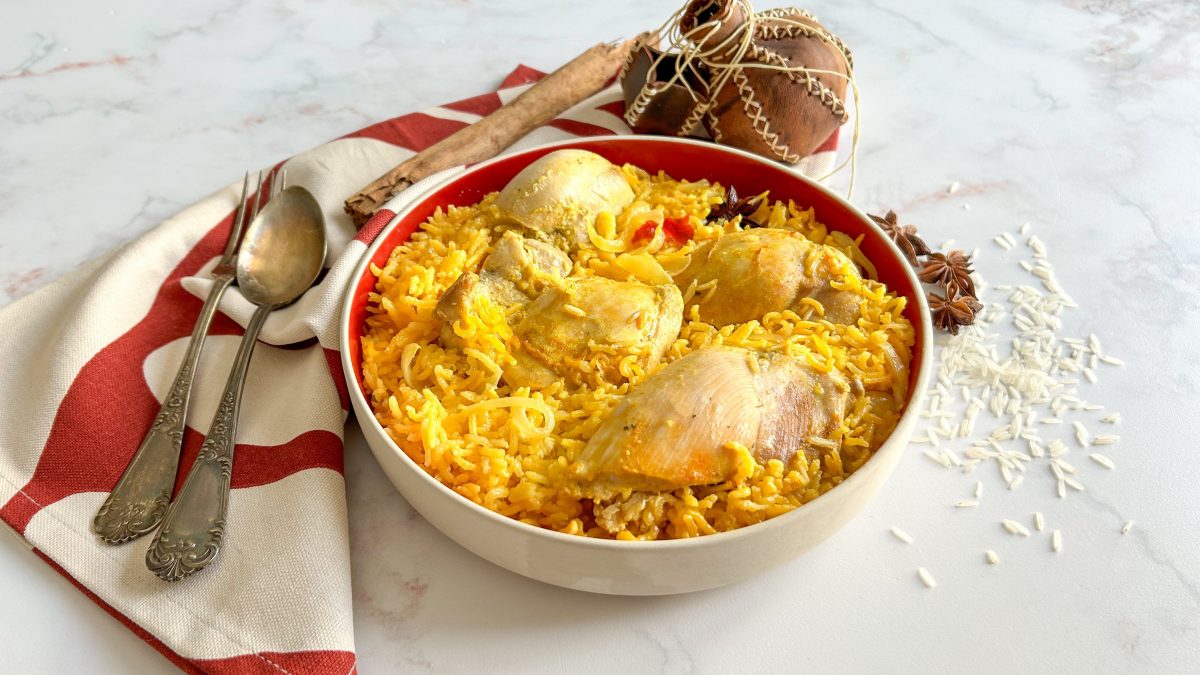
Chicken Biryani is an ancient Persian recipe, a richly spiced one-dish meal made with basmati rice and white meat, popular with slight variations throughout the Indian subcontinent, but also in the Arabian Peninsula and South Asia. The term biryani seems to derive from the Persian word beryā , meaning fried or roasted: in reality, the chicken is cooked in a pot first with spices and then together with the rice, but the name probably refers to the fact that the onions, thinly sliced, were cooked until golden and crispy.
In our version we prepared it with chicken thighs but, if you like, you can also buy the breast cut into bite-sized pieces, the drumsticks or turkey from your trusted butcher. Once you have marinated the meat in the fridge with whole plain yogurt, chili powder, lemon juice and a mix of curry and turmeric, all you have to do is transfer it to a saucepan together with the onions, previously left to fry with a base of butter and toasted herbs, then add a chopped fresh mint, the basmati rice and the boiling water in which you have dissolved the saffron, and then gently cook everything by absorption. The result will be a creamy and spicy dish, to serve for a family lunch or for an ethnic dinner in the company of guests.
What is Indian Chicken Biryani?
Chicken biryani, a beloved dish in Indian cuisine, boasts a rich history that intertwines Persian, Mughal, and South Asian culinary traditions. The term "biryani" is derived from the Persian word biryan, meaning "fried before cooking," reflecting the method of partially frying the rice before combining it with meat and spices. This cooking technique was introduced to the Indian subcontinent by Persian traders and travelers around the 13th century during the Delhi Sultanate era. Over time, the dish evolved, incorporating local spices and ingredients, leading to the diverse regional variations we enjoy today, such as Hyderabadi, Lucknowi (Awadhi), and Kolkata biryani.
The introduction of chicken biryani to the United States can be attributed to the South Asian diaspora, particularly from India, Pakistan, and Bangladesh, who began migrating in significant numbers during the late 20th century. As these communities settled in cities like New York, Chicago, and San Francisco, they brought with them their rich culinary heritage. Indian restaurants began to proliferate, offering authentic dishes, including chicken biryani, to a broader American audience. Over the years, the dish has gained popularity beyond South Asian communities, becoming a staple in many urban areas known for their diverse food scenes.
Pro Tips for The Best Chicken Biryani
- Basmati rice is a must for biryani. Its long, aromatic grains cook beautifully without becoming sticky. Rinse it thoroughly before cooking to remove excess starch and ensure fluffy rice.
- Marinate the chicken for at least 1–2 hours (or overnight if you can) to allow the spices to fully infuse the meat. This will make your chicken tender and flavorful.
- When assembling the biryani, layer the rice and chicken carefully to allow the flavors to infuse each other. Start with a layer of rice, then a layer of marinated chicken, and repeat. Finish with a final layer of rice on top.
- Once everything is assembled, cook the biryani on low heat (known as dum cooking) to ensure that the rice and chicken absorb all the spices and aromas without overcooking.
- Whole spices like cinnamon sticks, cardamom pods, and cloves add a deeper, more complex flavor to the biryani. Remember to remove them before serving, or at least warn your guests!
- Caramelized onions are essential for biryani. Fry them until they’re golden brown and crispy to add both texture and flavor. You can reserve some to garnish the top for an extra crispy crunch.
What Does Chicken Biryani Taste Like?
Chicken biryani has a rich, aromatic, and savory flavor profile with a perfect balance of spices. The tender chicken absorbs the flavors of the marinade, which often includes yogurt, garlic, ginger, and a variety of spices like cumin, coriander, cardamom, and cinnamon. The rice is fluffy and infused with the warm, earthy spices, while the caramelized onions add a touch of sweetness. The dish is also often garnished with fresh herbs like cilantro and mint, adding a refreshing contrast to the rich and complex flavors. The result is a comforting, slightly spicy dish with layers of depth, warmth, and fragrance.
What Meat is Used in Biryani?
Biryani can be made with various types of meat, depending on regional preferences and personal taste. The most common meats used in biryani are:
- Chicken: One of the most popular options, chicken biryani is tender and flavorful, absorbing the rich spices of the dish.
- Mutton: Often used in traditional biryanis, mutton (usually goat or lamb) offers a richer, deeper flavor due to its fat content and texture.
- Beef: In some regions, beef is used in biryani, especially in places where it’s more common.
- Pork: Less common, but some regions, like certain parts of South India, may incorporate pork into their biryani.
- Fish: Fish biryani is a lighter variation, commonly seen along coastal areas.
- Vegetarian: While not a meat, vegetarian biryani is made with a variety of vegetables like potatoes, carrots, peas, and sometimes paneer (Indian cheese).
Main Types of Biryani:
- Hyderabadi Biryani: Known for its rich flavors, it’s often made with mutton or chicken and features a blend of spices, cooked using the dum method (slow cooking in a sealed pot).
- Lucknowi (Awadhi) Biryani: This is a more delicate biryani made with chicken or mutton, where the rice and meat are cooked separately and then layered.
- Kolkata Biryani: A unique variation that includes potatoes along with the meat, and uses a slightly milder, aromatic spice mix.
- Sindhi Biryani: A spicier version, typically made with mutton or chicken, loaded with green chilies, and a generous amount of yogurt.
- Malabar Biryani: Popular in Kerala, it uses short-grain rice and often incorporates chicken or mutton, with a distinct blend of spices.
- Kashmiri Biryani: Known for its fragrant spices and use of dried fruits like raisins and apricots, this biryani often features chicken or mutton.
Is Chicken Biryani A Curry? Chicken Curry Vs. Chicken Biryani
No, chicken biryani is not considered a curry. While both are popular dishes in South Asian cuisine, the key difference lies in how they are prepared. Chicken biryani is a rice-based dish where chicken is marinated in spices, then cooked with rice and a variety of whole spices, resulting in a layered and aromatic dish. It’s typically dry or semi-dry.
On the other hand, curry generally refers to dishes where meat or vegetables are cooked in a sauce made from a mixture of spices, onions, tomatoes, and other ingredients, resulting in a more liquid consistency.
How Do I Avoid The Rice Sticking to The Bottom of The Pot?
To prevent the rice from sticking to the bottom of the pot when making biryani, rinse the rice well to remove excess starch, and parboil it until it's about 70-80% cooked. Use a heavy-bottomed pot to distribute heat evenly, and add some oil or ghee to the rice while boiling. During the dum cooking process, ensure the pot is sealed tightly, and avoid stirring too much, as this can release starch and cause the rice to stick.
Why is My Chicken Biriyani So Dry?
Your chicken biryani may be dry if the rice was overcooked or the chicken wasn’t marinated enough. It can also happen if there wasn’t enough moisture during the dum cooking process, or if the pot wasn’t sealed properly, causing the steam to escape. Adding a bit more water or stock next time can help maintain moisture.
Is Chicken Biryani Spicy?
Chicken biryani can be spicy, but the level of heat depends on the amount of chili and spices used in the recipe. While it typically features a mix of flavorful spices like cumin, cardamom, and cinnamon, the heat from fresh or dried chilies can vary. If you prefer less spice, you can adjust the amount of chili to suit your taste.
Can I Make It Ahead of Time?
Yes, you can make chicken biryani ahead of time. You can prepare the dish, store it in an airtight container, and refrigerate it for up to 2 days. When you're ready to serve, simply reheat it gently on low heat, adding a splash of water or broth to keep it moist and prevent it from drying out.
Does It Freeze Well?
Yes, chicken biryani freezes well. After cooking, let it cool completely, then store it in an airtight container or freezer bag. It can be frozen for up to 3 months. When ready to eat, thaw it overnight in the fridge and reheat it gently, adding a bit of water or broth to restore its moisture.
How to Store Any Leftovers
To store leftovers, place the chicken biryani in an airtight container and refrigerate for up to 2–3 days. Make sure it’s cooled down to room temperature before storing. When reheating, add a splash of water or broth to keep it moist and warm it up gently on the stovetop or in the microwave.
Ingredients
How to Make Chicken Biryani
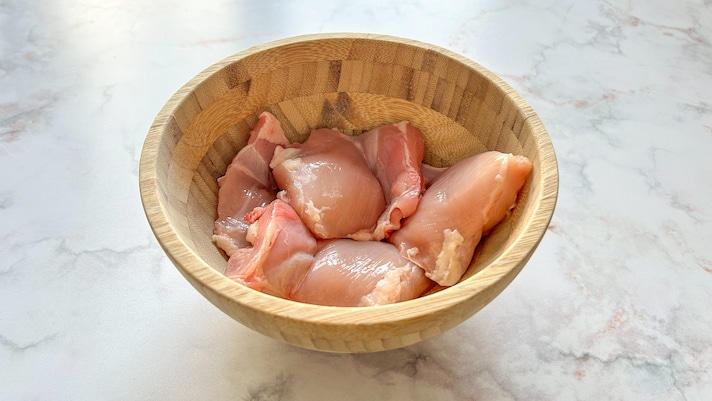
Place the meat in a bowl.
Place the meat in a bowl.
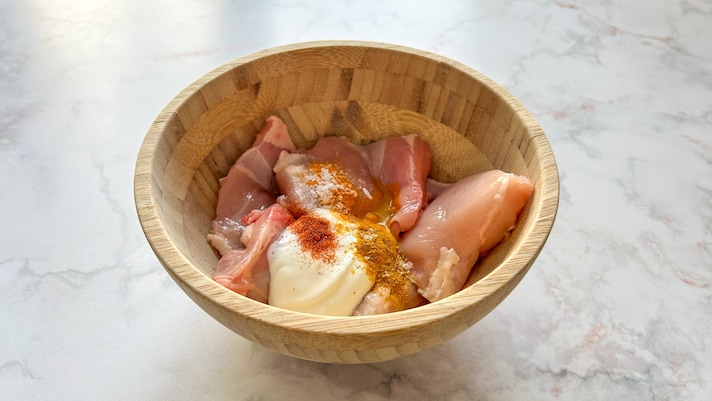
Add 25g of yogurt, the chili, the garlic powder, a pinch of salt, 1 teaspoon of curry and one of turmeric and pour the lemon juice.
Add 25g of yogurt, the chili, the garlic powder, a pinch of salt, 1 teaspoon of curry and one of turmeric and pour the lemon juice.
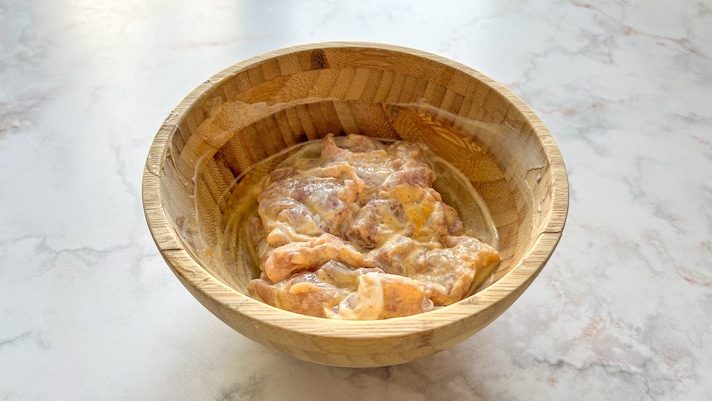
Mix the ingredients well, cover with a sheet of cling film and marinate in the fridge for 1 hour.
Mix the ingredients well, cover with a sheet of cling film and marinate in the fridge for 1 hour.

Once the time has passed, melt the butter in a saucepan, then add the bay leaves, the cinnamon stick, the cloves, the anise stars and the cardamom and, when the aromas begin to be released, pour in the onion finely chopped with a knife.
Once the time has passed, melt the butter in a saucepan, then add the bay leaves, the cinnamon stick, the cloves, the anise stars and the cardamom and, when the aromas begin to be released, pour in the onion finely chopped with a knife.

Let it wilt, stirring occasionally with a wooden spoon.
Let it wilt, stirring occasionally with a wooden spoon.
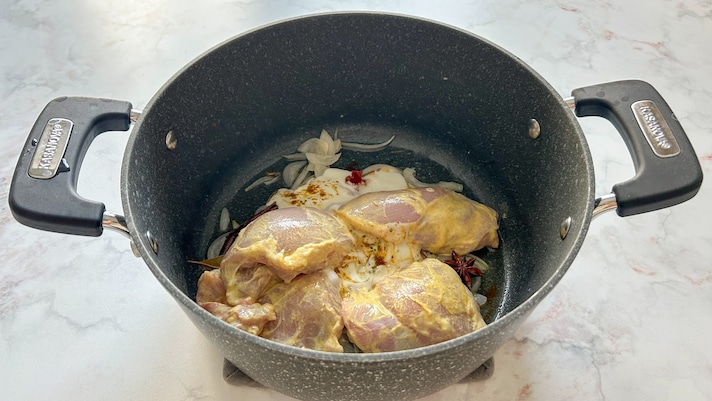
At this point, transfer the marinated chicken into the pan, along with the remaining yogurt and curry, and add the chopped mint leaves.
At this point, transfer the marinated chicken into the pan, along with the remaining yogurt and curry, and add the chopped mint leaves.

Add the basmati rice, already soaked for half an hour and rinsed thoroughly under running water.
Add the basmati rice, already soaked for half an hour and rinsed thoroughly under running water.
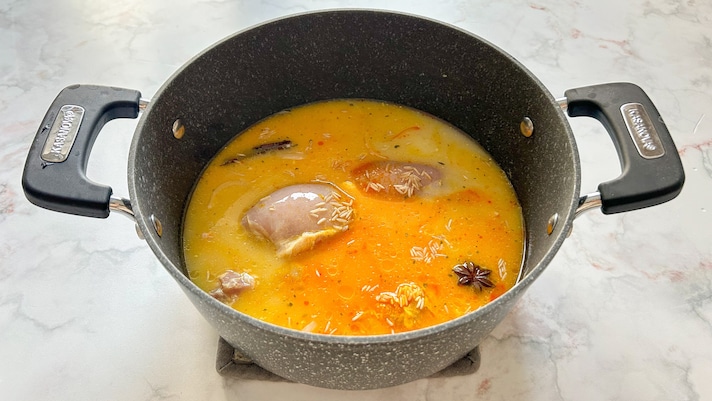
Cover with the hot water in which you have diluted the saffron and bring to the boil.
Cover with the hot water in which you have diluted the saffron and bring to the boil.
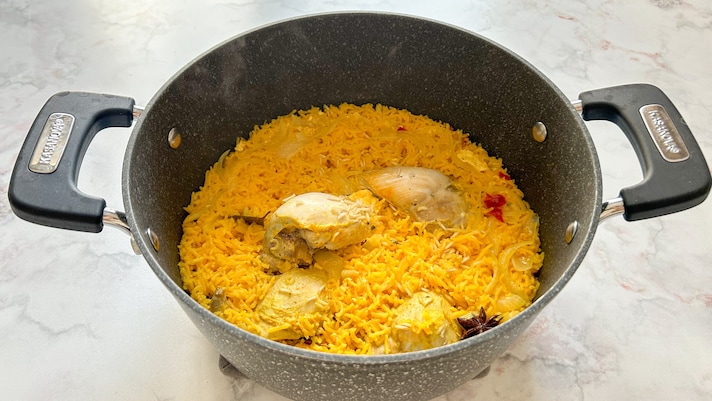
Then lower the heat and continue cooking until the liquid is completely absorbed.
Then lower the heat and continue cooking until the liquid is completely absorbed.

Enjoy!
Enjoy!
;Resize,width=767;)
